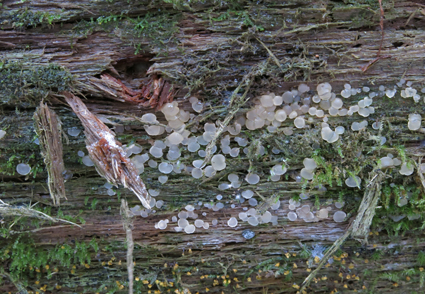Abstract
Ditiola haasii, a largely unknown member of the Dacrymycetes described from Germany, is documented in detail based on two specimens collected on Picea abies wood in the Boubínský prales virgin forest, Czech Republic. The work represents the first complete taxonomic/ecological investigation of the species since its original description. The morphology of the newly studied samples is evaluated to gain a better knowledge of intraspecific variation, and a phylogenetic analysis based on nrLSU data is provided to further confirm our identification and show the phylogenetic position of D. haasii within the Dacrymycetes. A comparison with similar species and those with which it has been confused is made and ecological details are provided based on our collections. Colour photographs of basidiomata and micromorphological characters are published. Ditiola haasii is currently documented by just six records worldwide, all of them from Central Europe.
References
<p>Gardes, M. & Bruns, T.D. (1993) ITS primers with enhanced specificity for basidiomycetes. Application to the identification of mycorrhizae and rusts. <em>Molecular Ecology</em> 2: 113–118. https://doi.org/10.1111/j.1365-294X.1993.tb00005.x</p>
<p>Heilmann-Clausen, J. (2001) A gradient analysis of communities of macrofungi and slime moulds on decaying beech logs. <em>Mycological Research</em> 105: 575–596. https://doi.org/10.1017/S0953756201003665</p>
<p>Heilmann-Clausen, J., Adamčík, S., Bässler, C., Halme, P., Krisai-Greilhuber, I. & Holec, J. (2017) State of the art and future directions for mycological research in old-growth forests. <em>Fungal Ecology</em> 27: 141–144. https://doi.org/10.1016/j.funeco.2016.12.005</p>
<p>Holec, J., Kříž, M., Pouzar, Z. & Šandová, M. (2015) Boubínský prales virgin forest, a Central European refugium of boreal-montane and old-growth forest fungi. <em>Czech Mycology</em> 67 (2) 157–226. https://doi.org/10.33585/cmy.67204</p>
<p>Holec, J., Kučera, T., Běťák, J. & Hort, L. (2020) Macrofungi on large decaying spruce trunks in a Central European old-growth forest: what factors affect their species richness and composition? <em>Mycological Progress</em> 19: 53–66. https://doi.org/10.1007/s11557-019-01541-y</p>
<p>Holec, J. & Kučera, T. (2020) Richness and composition of macrofungi on large decaying trees in a Central European old-growth forest: a case study on silver fir (<em>Abies alba</em>). <em>Mycological Progress</em> 19 (12): 1429–1443. https://doi.org/10.1007/s11557-020-01637-w</p>
<p>Huelsenbeck, J.P., Larget, B. & Alfaro, M.A. (2004) Bayesian phylogenetic model selection using reversible jump Markov chain Monte Carlo. <em>Molecular Biology and Evolution</em> 21: 1123–1133. https://doi.org/10.1093/molbev/msh123</p>
<p>Jülich, W. (1984) <em>Die Nichtblätterpilze, Gallertpilze und Bauchpilze</em>, <em>Kleine Kryptogamentflora, Vol. IIb/1</em>. Gustav Fischer Verlag, Jena, 626 pp.</p>
<p>Kalyaanamoorthy, S., Minh, B.Q., Wong, T.K.F., von Haeseler, A. & Jermiin, L.S. (2017) ModelFinder: fast model selection for accurate phylogenetic estimates. <em>Nature Methods</em> 14: 587–589. https://doi.org/10.1038/nmeth.4285</p>
<p>Krieger, W. (1906) Einige neue Pilze aus Sachsen. <em>Annales Mycologici</em> 4: 39–40.</p>
<p>McNabb, R.F.R. (1965) Taxonomic studies in the Dacrymycetaceae V. <em>Heterotextus</em> Lloyd. <em>New Zealand Journal of Botany</em> 3: 215–222. https://doi.org/10.1080/0028825X.1965.10428722</p>
<p>McNabb, R.F.R. (1973) Taxonomic studies in the Dacrymycetaceae VIII. <em>Dacrymyces</em> Nees ex Fries. <em>New Zealand Journal of Botany</em> 11: 461–524. https://doi.org/10.1080/0028825X.1973.10430296</p>
<p>Nguyen, L.-T., Schmidt, H.A., Von Haeseler, A. & Minh, B.Q. (2015) IQ-TREE: A fast and effective stochastic algorithm for estimating maximum likelihood phylogenies. <em>Molecular Biology and Evolution</em> 32: 268–274. https://doi.org/10.1093/molbev/msu300</p>
<p>Oberwinkler, F. (1989) <em>Ditiola haasii</em> <em>sp. nov.</em>, eine neue Art der Dacrymycetales. <em>Zeitschrift für Mykologie</em> 55: 197–206.</p>
<p>Oberwinkler, F. (2014) Dacrymycetes.<em> In: </em>McLaughlin, D.J. & Spatafora, J.W. (eds.) <em>The Mycota VII. Systematics and Evolution, part A</em>. Springer, Berlin, pp. 357–372. https://doi.org/10.1007/978-3-642-55318-9_13</p>
<p>Rambaut, A., Drummond, A.J., Xie, D., Baele, G. & Suchard, M.A. (2018) Posterior summarisation in Bayesian phylogenetics using Tracer 1.7. <em>Systematic Biology</em> 67: 901–904. https://doi.org/10.1093/sysbio/syy032</p>
<p>Ronquist, F., Teslenko, M., van der Mark, P., Ayres, D.L., Darling, A., Hohna, S., Larget, B., Liu, L., Suchard, M.A. & Huelsenbeck, J.P. (2012) MrBayes 3.2: Efficient Bayesian phylogenetic inference and model choice across a large model space. <em>Systematic Biology</em> 61: 539–542. https://doi.org/10.1093/sysbio/sys029</p>
<p>Shirouzu, T., Matsuoka, S., Doi, H., Nagata, N., Ushio, M. & Hosaka, K. (2020) Complementary molecular methods reveal comprehensive phylogenetic diversity integrating inconspicuous lineages of early-diverged wood-decaying mushrooms. <em>Scientific Reports</em> 10: 3057. https://doi.org/10.1038/s41598-020-59620-0</p>
<p>Vilgalys, R. & Hester, M. (1990) Rapid genetic identification and mapping of enzymatically amplified DNA from several <em>Cryptococcus</em> species. <em>Journal of Bacteriology</em> 172: 4238–4246. https://doi.org/10.1128/jb.172.8.4238-4246.1990</p>
<p>Weiβ, M. & Oberwinkler, F. (2001) Phylogenetic relationships in Auriculariales and related groups – hypotheses derived from nuclear ribosomal DNA sequences. <em>Mycological Research</em> 105: 403–415. https://doi.org/10.1017/S095375620100363X</p>
<p>Zamora, J.C. & Ekman, S. (2020) Phylogeny and character evolution in the Dacrymycetes, and systematics of Unilacrymaceae and Dacryonaemataceae fam. nov. <em>Persoonia</em> 44: 161–205. https://doi.org/10.3767/persoonia.2020.44.07</p>


